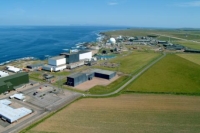Exotic fuel on the move
22 February 2013
The UK's Nuclear Decommissioning Authority (NDA) has decided to transfer remaining stocks of nuclear fuels from the Dounreay site to Sellafield. The move will enable Dounreay's security status to be significantly downgraded.
 |
| Dounreay (Image: DSRL/NDA) |
The fuel in question is from UK nuclear research programs spanning more than four decades. Referred to as 'exotic', the fuels which contain plutonium and high-enriched uranium are potentially recyclable and are therefore not classified as waste, but require enhanced security. Around 100 tonnes of irradiated and unirradiated fuel is currently stored at Dounreay in facilities that are reaching the end of their design lives. Some 26 tonnes of this is classified as exotic.
The fuel includes around 13 tonnes of unirradiated plutonium fuels containing a total of 2 tonnes of plutonium, in the form of powders, metal coupons, pellets and pins; one tonne of unirradiated high-enriched uranium fuels in the form of oxide powders, pellets, uranium metals and alloys; and about 12 tonnes of irradiated fuel from the Prototype Fast Reactor, which operated at Dounreay from 1959 to 1977.
The NDA has been exploring two options: keeping the fuel in storage at Dounreay, in the northernmost part of Scotland, requiring the construction of new facilities and maintenance of the site's high-security status; or transferring it to the Sellafield complex in north-west England, where a larger inventory of high-security material is already stored and managed. This would enable the Dounreay exotics to be co-managed with other very similar materials, while offering security advantages, the NDA notes.
After considering the views of stakeholders and regulators, the NDA announced the choice of transfer to Sellafield as its preferred option. The material will be transferred from Dounreay to Sellafield by rail or sea, depending on the type of material being transported, with 30-40 journeys expected to take place over a period of around six years. Assuming final approvals are granted, the first transport is expected to take place around 2014-2015. Safety case and planning approvals required to implement the strategy will be executed by Sellafield and Dounreay.
The unirradiated fuels will require pre-treatment before transportation, while the irradiated fuels require special handling and transport arrangements. Dounreay will retain the highest level of security categorisation until all of the exotics have been removed from the site, after which its security status can be downgraded.
Site licensee Dounreay Site Restoration Limited (DSRL) welcomed the announcement. Alex Anderson, deputy project director for fuels and waste at Dounreay, said the decision would enable the company to refine its site closure plans."We will now work with Sellafield Sites Ltd and the NDA's own transport companies to plan and implement this decision, obtain the necessary regulatory approvals and remove the last of the nuclear fuel from the site. The safety and security of this material will be paramount throughout," Anderson promised.
The NDA has already embarked on a strategy to minimise the number of sites where such legacy materials are stored, and transportation of non-exotic Dounreay nuclear fuel to Sellafield began in December 2012.
Researched and written
by World Nuclear News